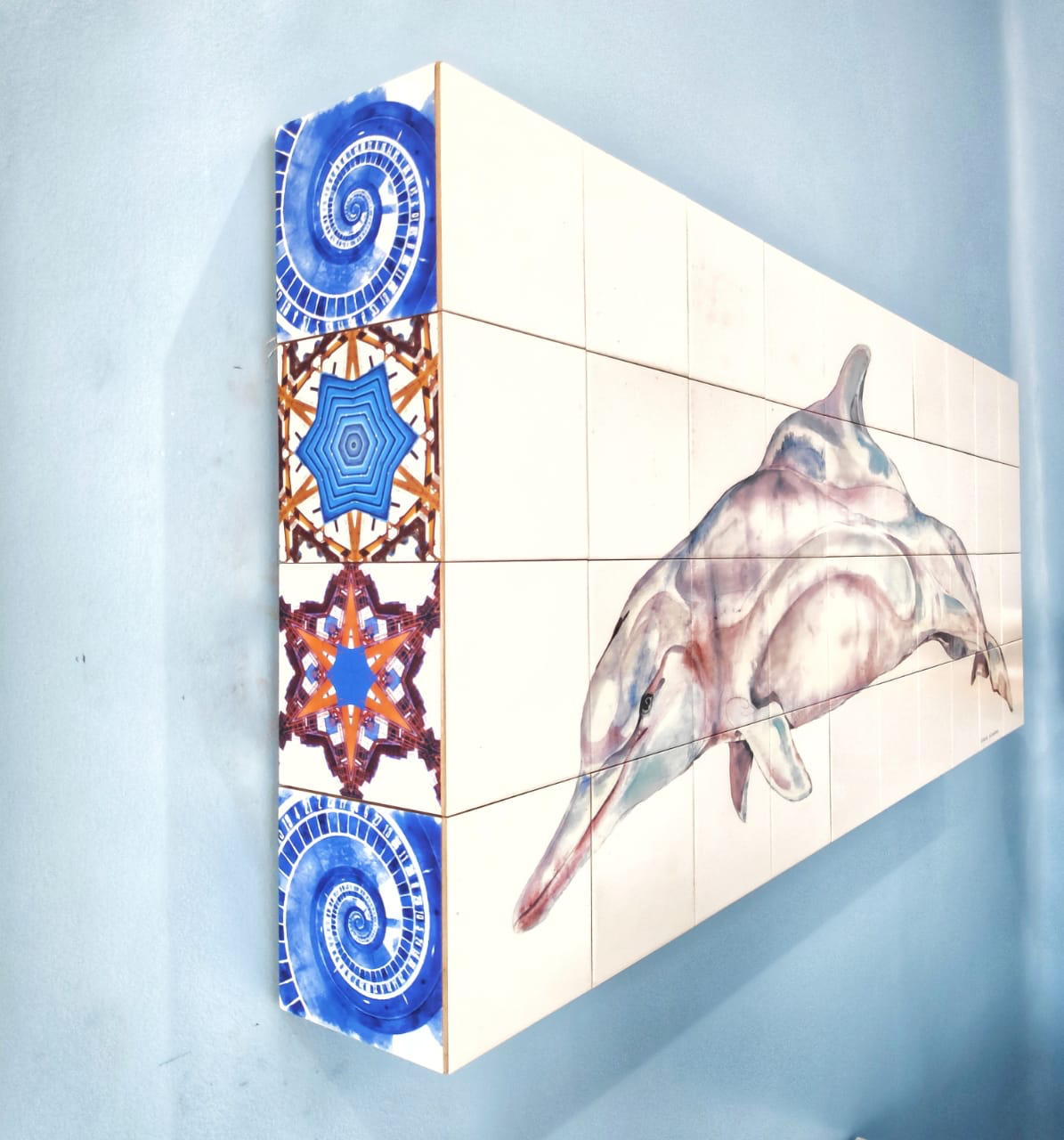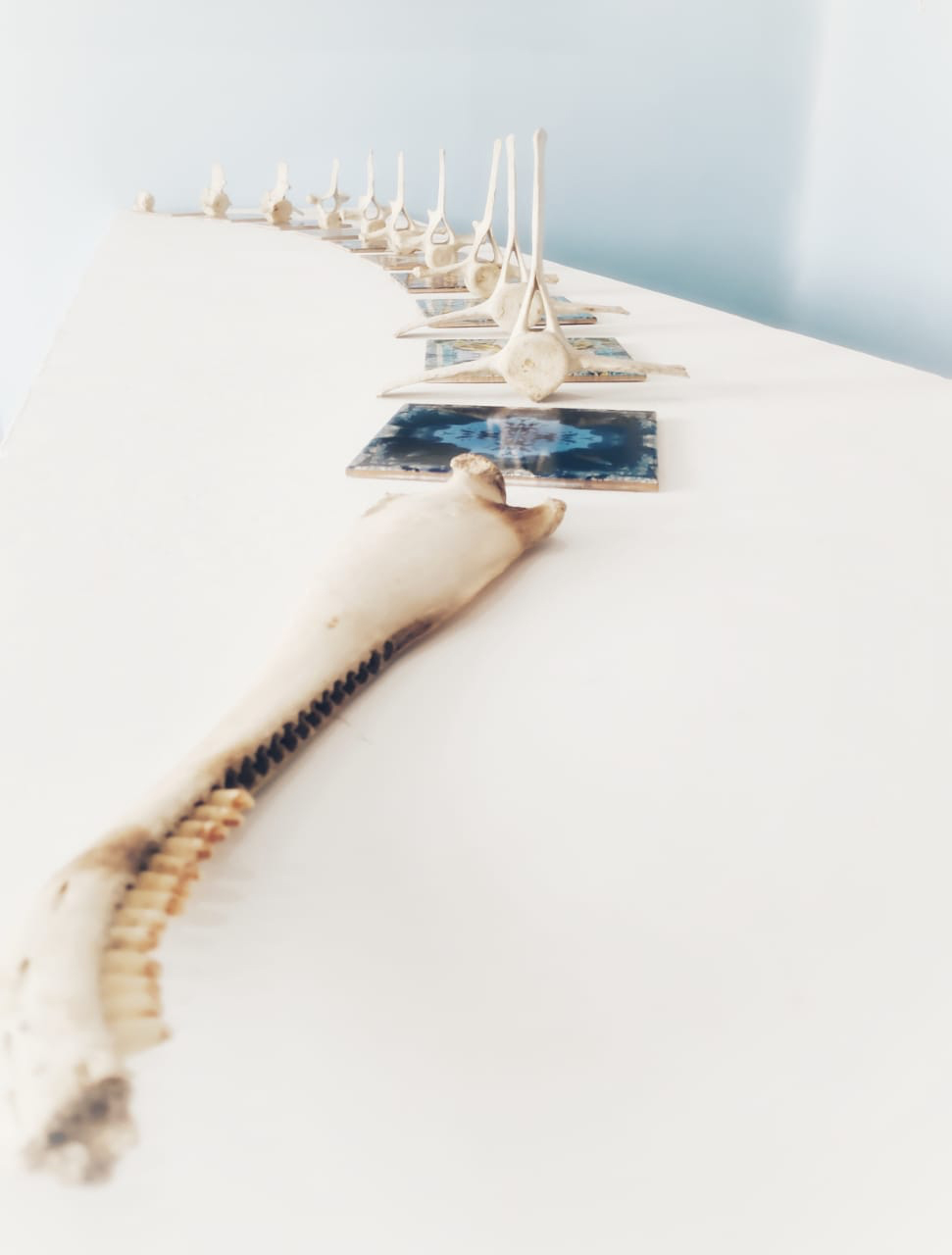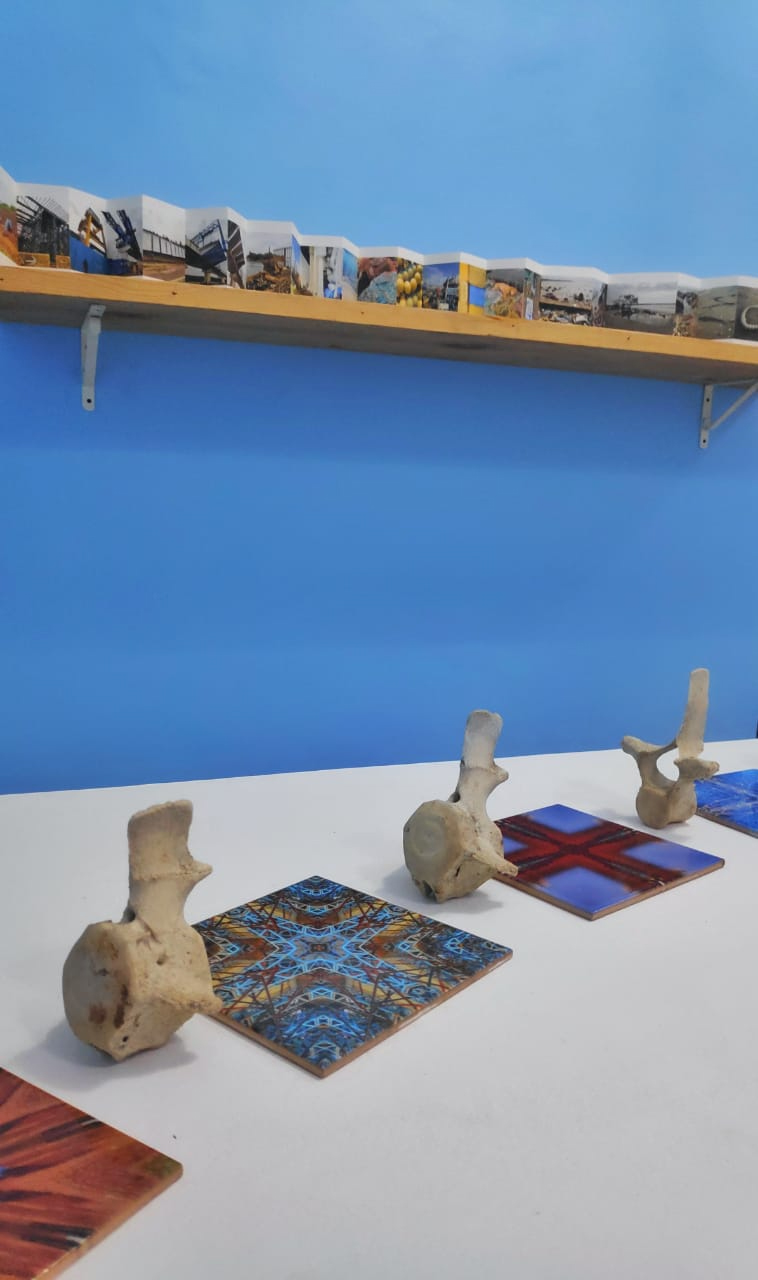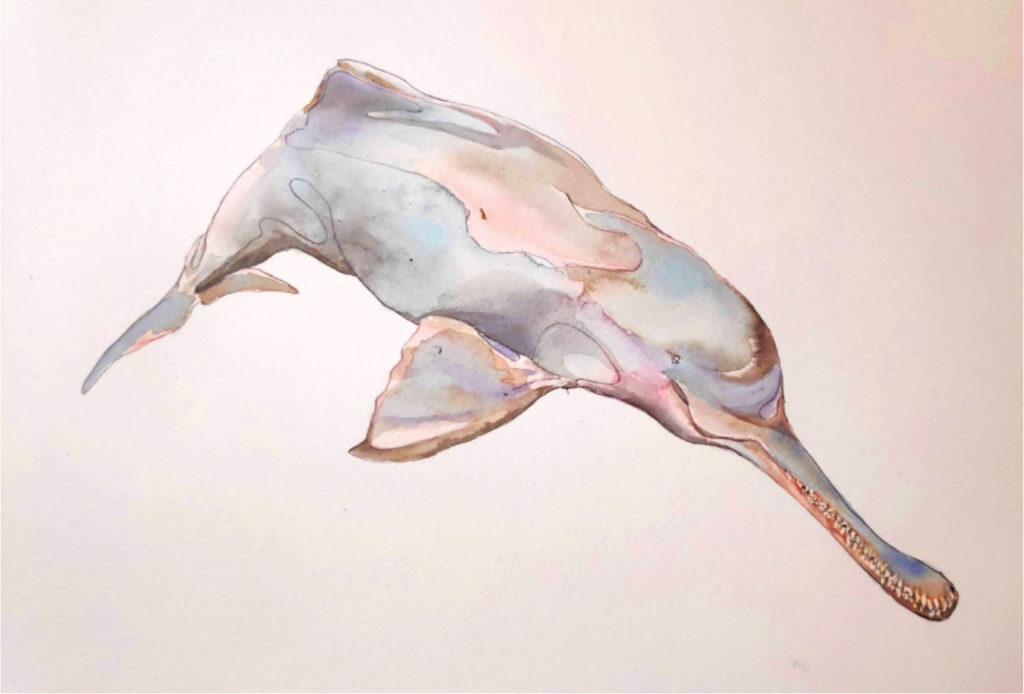I try to bridge my concerns for pressing issues like climate change, pollution, garbage and biodiversity loss, with solutions and practices from permaculture and ecological morality. My dream is to build a sustainable living community.
Waylon James D’Souza talks about his twin inspirations – biomimicry and sustainability – and takes us through his process and frameworks.

The Cascade of Futures Past: Journey Through the Eocene and Speculations on the Post-silicon Age.
Industrial designer, artist, performer, and speaker: what were your motivations for moving from one to the next? Tell us about your journey.
When I was younger, I wanted to become a botanist or zoologist. There was an underlying fascination for the larger picture, the connect between microcosms and macrocosms. I trained in a matrix of symbiotic disciplines including animation, industrial design, aquaponics, permaculture, fine art, and performance art. In the backdrop of these skills, I wondered if we could achieve synergy between development and ecology, two seemingly conflicting aspirations.
One journey began at an office in 2008, where I was asked to do textural design for products. I wanted to go beyond. While noticing how much waste these one dimensional products create once they are obsolete, I turned back to observing and recreating ecosystems. I was also observing traditional products and their materials and life cycles, along with lifestyles of their makers.
I did not choose to move from one to the next, but a series of people and places facilitated me in this endeavours.
Along with my studies, I travelled to the Western Ghats, Kerala, and other urban markets, collecting plant specimens for my aquaponic experiments. I infused these into an urban garden project, which evolved into ‘The Botanical Lab’, which was an experiential project, where plants are allowed to grow freely, where you don’t segregate but integrate.

Installation view. Natural selection : A spore of atlantropa for Azulejo-Mundo Goa at Serendipity Arts Festival, 2019
How did your tryst with art begin?
For around two decades my painting and sketching were in a state of dormancy, but it is surfacing again. With my passion for science and research and my proclivity towards design and art, I mapped out what I had done over the years and saw the interconnectedness of everything. It led me to contemplate deeper. It helped me understand the economics and biology of waste. Art allowed me to take it further. I began to tell stories, express my research, and find solutions.

Installation view. Natural selection : A spore of atlantropa for Azulejo-Mundo Goa at Serendipity Arts Festival, 2019
What inspires you?
Biomimicry. I try to bridge my concerns for pressing issues like climate change, pollution, garbage and biodiversity loss, with solutions and practices from permaculture and ecological morality. My dream is to build a sustainable living community.
Hierarchical capitalist frameworks and compartmentalisation has lead to ignorance and an inability to experience collective evolution, thus negating our plurality, just like semantic challenges in valuing ecosystem services. Yet, it is often these less tangible ecosystem services that shape societies, culture and welfare, and often drive environmental change. I persevere to effectuate their analysis through my installations and works. The way I comprehend these nuances are more like rhizomatic and mycelial structures, like that of a forest or the blueprints of our internet or even the cosmos.

Story of Light, Goa, 2018
Take us through your process.
It starts off from a point of origin of possibilities that spirals in from a union of past experiences, which is then multiplied by further research to be magnified into a kaleidoscope of more possibilities – artistic, scientific, or design-based. This then gets distilled as priorities by a logistics run through, where the execution is a journey more than a destination. Finally, there is contemplation and assessment. These are kind of quadrants I have created to help me preview my ideas and plans, but in a circular format, like crop rotation. My artworks and installations are designed to aesthetically and symbolically represent crises in the ecological paradigms.

Have you been on the other side, as a part of the audience? Which exhibitions, performances and experiences have shaped or altered your perspective? Who are your maestros?
Natural history museums, landscapes, water bodies, cuisine and consumption, scientific discourse, literature and documentaries have been the exhibits that have influenced me. People like Paul Stamets, Noam Chomsky, Patrick Blanc, Masanobu Fukuoka, Pranay Lal, Carol Black, Cosima Dannoritzer, Hugh Fearnley and Viktor Schauberger are some of the people who have created fluid and crystalline perspectives for my ideology.
Events like Serendipity Arts Festival and Kochi Biennale along with some private exhibits have helped me observe various articulations of concepts and curation.

Story of Light, Goa, 2018
What are the biggest challenges in your work?
Since many of my ventures require a matrix of trained people, along with infrastructure to support it, I created a multidisciplinary studio. While it is on the back-burner now, I am waiting for additional ingredients to churn out a constant regenerative outcome.
Trying to articulate these complex networks and fluid non-crystallised stories can be hard with every guild or unique individual. Shorter attention spans, and requests for oversimplification and compartmentalisation for instant effect or gratification is a trivialising process. It’s like trying to simplify a complex ecosystem food web by severing the ether connecting various functions into a linear summary. Since valuation processes in many modern societies are often achieved through monetary measurement, less tangible elements are frequently left out of the traditional valuation framework. Similarly art, science, philosophy, education, economics and governance should cross pollinate for the sake of its own health.

The Cascade of Futures Past: Journey Through the Eocene and Speculations on the Post-silicon Age.
What trends have you observed in the world?
Specialisation and specificity has become the norm, and has its repercussions. It is like a horse with blinders fitted to reach a destination efficiently; peripheral vision is sacrificed or denounced for success in a capitalistic globe. The horse is reliant on externalities to rein it to the path, the milestones or the cliffs. It can then be manipulated, so long as there is promised fodder, it does not question. The horse is constantly at the mercy of the rider, and the rider is constantly at the mercy of its vigilance.
Will art, which has been labelled to have created change, stand the test of time as cautionary lessons? Or is this a lesson to reinvent how we use art as a medium in our current times to avoid monotonous history from repeating itself, but rather for evolution?

Installation view. Natural selection : A spore of atlantropa for Azulejo-Mundo Goa at Serendipity Arts Festival, 2019
How do you balance life and art?
When it comes to fluid ideology, just like water bodies in different stages, there are moments of Kierkegaardian angst and Zen-like Buddhist contentment. They feed off each other. They are just sides of the same spectrum. It’s been a long journey to achieve that balance though.

Self portrait for Azulejo-Mundo Goa at Serendipity Arts Festival, 2019
What’s coming next season?
Next up is Azulejo-Mundo Goa at Serendipity Arts Festival, 2019. This process-driven exhibition features 25 Goa-based artists under the age of 40, who first came together in June at the lovely heritage headquarters of Instituto Camões (IC) at the Casa Basilio Dias on the Panjim waterfront, to study and learn about the iconic Islamic-Iberian ceramic tile-work.

A wedding arch made of wild weeds and urns with leaf-imprints of local species.
How much research, time and iterations did it take for you to come up with your project The Cascade of Futures Past: Journey Through the Eocene and Speculations on the Post-silicon Age?
It was a heavily research driven incubator, from concerns about water in the country. I delved into the past, spanning from before the Indian subcontinent clashed into Eurasia, to the birth of the third pole and its cradle of civilizations, current ecological and economic scenarios, to near future events with the use of sacred geography to condense and compile different constituents of our past and current national agro-political and development decisions, creating a basin for an intuitive speculation of the future it will precede. It grew from conversations with curator Adwait Singh.

Installation view. Natural selection : A spore of atlantropa for Azulejo-Mundo Goa at Serendipity Arts Festival, 2019
How does the audience interact and react to the unexpected?
People generally take away different interpretations and understanding to whatever depths they are capable of taking in. Audiences have always been intrigued when I transmute a material from its raw form to another, or alter the perception of an otherwise ugly or obsolete material into a recognisable form.
How is this going to evolve? Is there a future avatar in the pipeline?
I am looking to connect, collaborate and work with scientists, researchers, educationists, and like-minded people to observe, document, and interact with places, objects, cultures and anomalies through lenses.

Watercolour works for Azulejo-Mundo Goa at Serendipity Arts Festival, 2019
How do you describe yourself in the context of challenging people’s perspectives via your work and art?
Nick Lovegrove had elaborated on the danger of having too many experts. Ever increasing specialisation has become the central premise for how we organise society. Contemporary challenges like income inequality, climate change, healthcare access and policing strategy cannot be solved by narrow technical specialists. To meet these challenges, specialist expertise is necessary but not sufficient. The worlds of business, government and social action increasingly operate in independent, hermetically sealed silos of specialisation. This is an issue I feel I’m in the midst of, and would want to further investigate, learn and remedy through my experiences and skills.












Add Comment